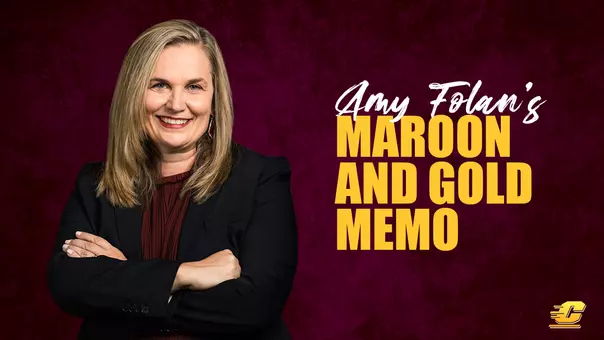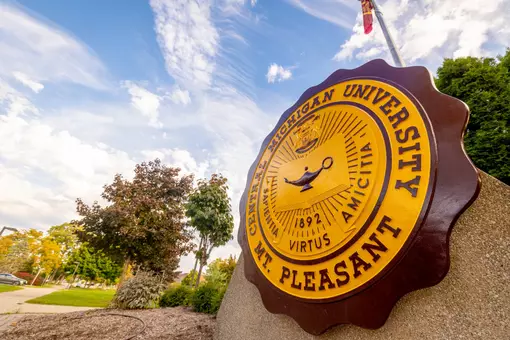Central Michigan University Athletics

Dr. Noshir Amaria is Central Michigan's Medical Director/Head Team Physician.
Photo by: Jack Reeber '23,M'25 - @jackreeber.raw
The Good Doctor Knows What It's Like To Battle
9/14/2021 4:34:00 PM | General
MOUNT PLEASANT, Mich. – The path that Dr. Noshir Amaria has chosen has not been easy.
Certainly, a strong intellect helped. But more than that, it's been perseverance, heart, attitude, sheer will and drive that have him where he is today.
"If you would have told me five years ago when I was doing my fellowship, 'You're going to be the head team physician for a team that takes the field at Death Valley, at LSU,' I would have laughed in your face," Amaria said.
But that's exactly where Amaria is today as Central Michigan Athletics' Medical Director/Head Team Physician. He will accompany the CMU football team to Baton Rouge on Saturday night when the Chippewas take on LSU at Tiger Stadium, better known as Death Valley.
CMU will be a decided underdog against its Southeast Conference opponent. Fitting that Dr. Amaria will be in CMU maroon and gold. He too was an underdog at one time.
Born in England to parents of Indian descent, Dr. Amaria moved with his family to suburban Detroit when he was 3 years old. Six years later, Dr. Amaria's physician father, Yazdi, opened his own practice in Sturgis, which is located on the Michigan-Indiana border.
At Sturgis High School, Dr. Amaria became involved in the school's acclaimed athletic training program and from there it was on to Michigan State where he earned a bachelor's degree in kinesiology with athletic training specialization.
He spent two years working as a trainer and then, at the prodding of doctors who worked in MSU athletics and with the family pedigree, he entered medical school in 2006.
A bachelor's degree is one thing. Med school? Welcome to the big leagues, kid.
"Nobody skates by," Dr. Amaria said. "You have to survive."
He did. But it wasn't easy, and he was always on edge and was consistently reminded that he wasn't a blue chipper, to borrow a term from the collegiate athletic world.
"I was told by a professor in athletic training that I wasn't going to get into medical school," Dr. Amaria said. "Then I got into medical school, and I had a professor saying, 'I don't think you're going to survive.'
"And then it was one of the deans of the medical school saying, 'Hey, why should we believe you're capable of doing anything your peers are doing?' My response was, 'You get me into the hospital; you get me in to see patients; I'll show you what I can do whatever my peers are doing.'"
Practice is one thing; game day is altogether different. Dr. Noshir Amaria was proving himself a gamer.
Part of that was a visceral instinct that came from years of watching his father care for patients. Some things you can't learn from a book or a lecture, and the first two years of med school are overwhelmingly just that.
"I had to survive that part of it," he said. "Yeah, I got my butt handed to me pretty hard in the first year of medical school, but thankfully I didn't get kicked out and I survived it."
Dr. Amaria said he was an anomaly among med students: He knew exactly what he eventually wanted to do and that was be a team physician for a Division I school.
With his parents still in Sturgis, he didn't want to stray far from home so he contacted a dozen universities located in the Midwest. CMU came calling and in 2017.
Certainly, he could have joined any number of clinics or rehabilitation facilities as opposed to making his way into the world of intercollegiate athletics. The financial rewards would, unquestionably, be better and a five-day, 40-hour work week may sound particularly appealing to Dr. Amaria when he's returning to campus in the wee hours of the morning after a long road trip.
"You do it because you enjoy teaching, you enjoy being around students, you enjoy being around the school, and you enjoy being around the younger population," said Dr. Amaria, who also serves as an assistant professor of family medicine and sports medicine at CMU College of Medicine.
There is more to a career – and to life – than a paycheck. There's the passion and the juice of being a member of a team and the enthusiasm and the genuine bright hopes of the young people you are charged with keeping healthy can be contagious.
In short, it gets in the blood.
"I'm a sideline junkie," Dr. Amaria said. "Being a part of the process when (student-athletes) get hurt and then being a part of getting them back to the day when they can get back on the court or back on the field, that's the thing that makes me feel good about what I'm doing. To see them come back, that's my reward."
One of the great joys of the profession, Dr. Amaria said, is diagnosing a student-athlete and then giving a prognosis based on sound medical precedent.
"The thing that no medical textbook can ever tell you is about someone's heart and their dedication and their perseverance," he said. "Yeah, I have to give them a timeline and I'll give them the most likely timeline based on (experience), but the way that timeline changes is about how good they do, how committed they are."
Dr. Amaria, who struggled early in med school and then shined when it was time to go to work, isn't a whole lot different than many of the student-athletes he oversees at CMU.
"My whole career has been, 'please doubt me; please tell me I can't do something because I'm going to show you that I can,'" he said. "That's what I use to try and inspire my med students I teach here at CMU.
"Athletes are told by doctors like me that you're not going to come back or it's going to take a year for you to get back and they have that chip on their shoulder and it's like 'I'll show this doctor.'
"I had the chip on my shoulder too."
Certainly, a strong intellect helped. But more than that, it's been perseverance, heart, attitude, sheer will and drive that have him where he is today.
"If you would have told me five years ago when I was doing my fellowship, 'You're going to be the head team physician for a team that takes the field at Death Valley, at LSU,' I would have laughed in your face," Amaria said.
But that's exactly where Amaria is today as Central Michigan Athletics' Medical Director/Head Team Physician. He will accompany the CMU football team to Baton Rouge on Saturday night when the Chippewas take on LSU at Tiger Stadium, better known as Death Valley.
CMU will be a decided underdog against its Southeast Conference opponent. Fitting that Dr. Amaria will be in CMU maroon and gold. He too was an underdog at one time.
Born in England to parents of Indian descent, Dr. Amaria moved with his family to suburban Detroit when he was 3 years old. Six years later, Dr. Amaria's physician father, Yazdi, opened his own practice in Sturgis, which is located on the Michigan-Indiana border.
At Sturgis High School, Dr. Amaria became involved in the school's acclaimed athletic training program and from there it was on to Michigan State where he earned a bachelor's degree in kinesiology with athletic training specialization.
He spent two years working as a trainer and then, at the prodding of doctors who worked in MSU athletics and with the family pedigree, he entered medical school in 2006.
A bachelor's degree is one thing. Med school? Welcome to the big leagues, kid.
"Nobody skates by," Dr. Amaria said. "You have to survive."
He did. But it wasn't easy, and he was always on edge and was consistently reminded that he wasn't a blue chipper, to borrow a term from the collegiate athletic world.
"I was told by a professor in athletic training that I wasn't going to get into medical school," Dr. Amaria said. "Then I got into medical school, and I had a professor saying, 'I don't think you're going to survive.'
"And then it was one of the deans of the medical school saying, 'Hey, why should we believe you're capable of doing anything your peers are doing?' My response was, 'You get me into the hospital; you get me in to see patients; I'll show you what I can do whatever my peers are doing.'"
Practice is one thing; game day is altogether different. Dr. Noshir Amaria was proving himself a gamer.
Part of that was a visceral instinct that came from years of watching his father care for patients. Some things you can't learn from a book or a lecture, and the first two years of med school are overwhelmingly just that.
"I had to survive that part of it," he said. "Yeah, I got my butt handed to me pretty hard in the first year of medical school, but thankfully I didn't get kicked out and I survived it."
Dr. Amaria said he was an anomaly among med students: He knew exactly what he eventually wanted to do and that was be a team physician for a Division I school.
With his parents still in Sturgis, he didn't want to stray far from home so he contacted a dozen universities located in the Midwest. CMU came calling and in 2017.
Certainly, he could have joined any number of clinics or rehabilitation facilities as opposed to making his way into the world of intercollegiate athletics. The financial rewards would, unquestionably, be better and a five-day, 40-hour work week may sound particularly appealing to Dr. Amaria when he's returning to campus in the wee hours of the morning after a long road trip.
"You do it because you enjoy teaching, you enjoy being around students, you enjoy being around the school, and you enjoy being around the younger population," said Dr. Amaria, who also serves as an assistant professor of family medicine and sports medicine at CMU College of Medicine.
There is more to a career – and to life – than a paycheck. There's the passion and the juice of being a member of a team and the enthusiasm and the genuine bright hopes of the young people you are charged with keeping healthy can be contagious.
In short, it gets in the blood.
"I'm a sideline junkie," Dr. Amaria said. "Being a part of the process when (student-athletes) get hurt and then being a part of getting them back to the day when they can get back on the court or back on the field, that's the thing that makes me feel good about what I'm doing. To see them come back, that's my reward."
One of the great joys of the profession, Dr. Amaria said, is diagnosing a student-athlete and then giving a prognosis based on sound medical precedent.
"The thing that no medical textbook can ever tell you is about someone's heart and their dedication and their perseverance," he said. "Yeah, I have to give them a timeline and I'll give them the most likely timeline based on (experience), but the way that timeline changes is about how good they do, how committed they are."
Dr. Amaria, who struggled early in med school and then shined when it was time to go to work, isn't a whole lot different than many of the student-athletes he oversees at CMU.
"My whole career has been, 'please doubt me; please tell me I can't do something because I'm going to show you that I can,'" he said. "That's what I use to try and inspire my med students I teach here at CMU.
"Athletes are told by doctors like me that you're not going to come back or it's going to take a year for you to get back and they have that chip on their shoulder and it's like 'I'll show this doctor.'
"I had the chip on my shoulder too."
Chippewa Check-In
Friday, November 07
Chippewa Check-In
Friday, October 31
Chippewa Check-In
Friday, October 24
Chippewa Check-In
Friday, October 17





